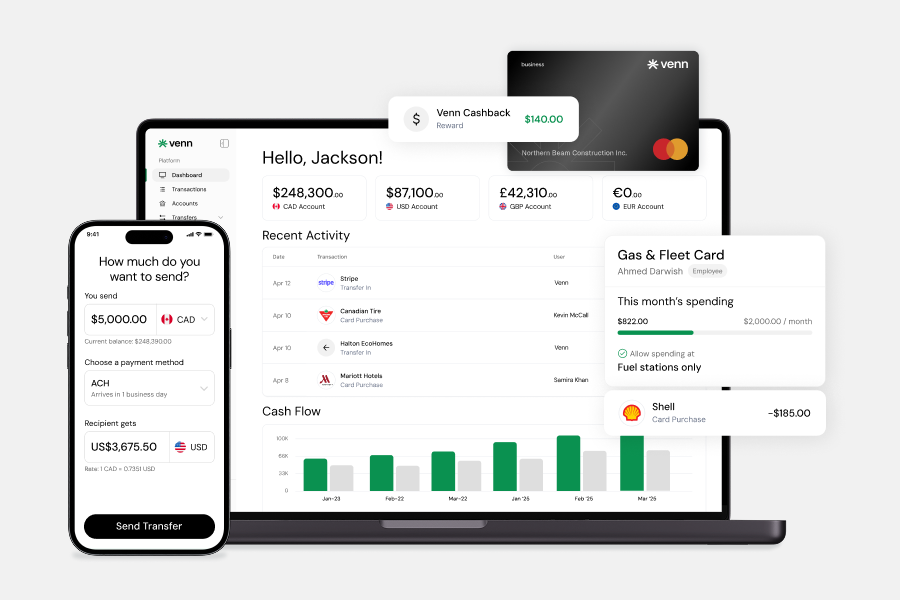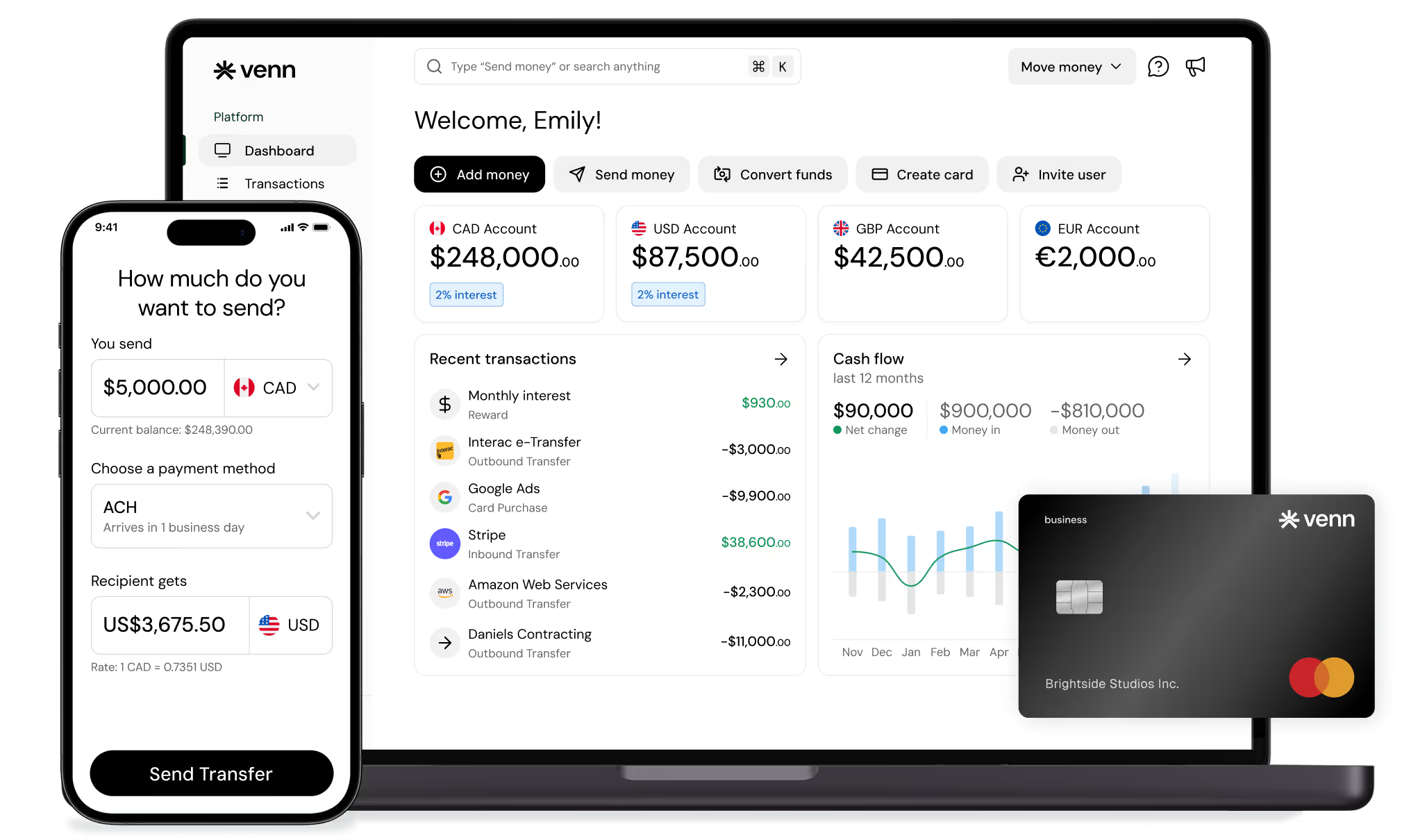Cash Flow Forecast Template for Canadian SMBs: Free Download + Guide
Plan smarter and avoid cash shortfalls with this free cash flow forecast template for Canadian small businesses. Includes step-by-step instructions, sample use case, and FX tips.


Trusted by 5,000+ Canadian businesses
Business banking for Canada
Local CAD and USD accounts, corporate cards with cashback, the lowest FX rates in Canada, free local transfers, and more.
If you're running a business in Canada, there's one financial metric that matters more than profit on paper, your actual cashflow.
Cash flow reflects the real-time movement of money in and out of your business. Even profitable companies can run into serious trouble if they don’t have enough available funds to cover bills, payroll, or unexpected expenses. That’s why understanding what your cashflow is, and how to predict it, is critical to staying in control.
This is where a cash flow forecast template becomes invaluable. Whether you’re prepping for tax season, planning a hiring decision, or dealing with cross-border vendors, a forecast helps you visualize future inflows and outflows, spot gaps early, and make smarter financial decisions.
For Canadian small businesses, forecasting is especially important because:
- GST/HST remittance can impact cash timing significantly.
- Payroll frequencies (bi-weekly, semi-monthly) require precision.
- Cross-border payments to US vendors or platforms often involve FX conversion fees and timing delays that can disrupt working capital.
Whether you're asking "how do I calculate cash flow?" or simply wondering "what is my cashflow right now?", this guide and downloadable template will give you the clarity and tools to answer confidently.
Key Concepts: What Goes Into a Cash Flow Forecast
Before you dive into any spreadsheet or tool, it's important to understand the building blocks of a cash flow forecast. At its core, a forecast maps cash inflows and outflows over a set time period, typically weekly or monthly, to help you answer questions like:
- What is my cashflow next month
- Can I afford this upcoming expense
- When will I run out of working capital if revenue slows
Here's a simple cashflow formula that shows the structure:
Cash Inflows - Cash Outflows = Net Cash Position
Common Inflows (Cash Coming In)
- Customer payments (invoiced or point-of-sale)
- Tax refunds, such as GST or HST credits
- Capital injections from investors or owners
- Intercompany transfers
- Currency conversions from international customers
Common Outflows (Cash Going Out)
- Payroll, usually bi-weekly or semi-monthly for Canadian SMBs
- Rent, utilities, and lease expenses
- Vendor or contractor payments via Interac e-Transfer or wire
- GST or HST remittances
- Software subscriptions and SaaS tools
- Transfers across currency accounts
Key Assumptions to Include
- Timing of payments: Will clients pay within terms or delay 30 to 60 days
- Runway: How many weeks of expenses can you cover with available funds
- Currency exposure: If you're collecting in USD but spending in CAD, forecast based on realistic FX rates and conversion timing
Cashflow Example
Take a construction firm that receives a $50,000 payment from a project. That same month, they owe $35,000 in payroll, $8,000 for materials, and $5,000 in GST. Without a forecast, they could misallocate those funds and fall short. A simple cash flow plan makes this visible before it's a problem.
How to Build a Cash Flow Forecast: Step by Step
Creating a cash flow forecast does not require complex software. With the right structure and a repeatable process, you can build one in Excel or Google Sheets using a downloadable template.
Below is a simple approach for building a cash flow forecast that reflects Canadian business realities, from GST remittances to payroll timing and FX considerations.
1. Choose Your Forecast Period
Most small businesses start with a monthly forecast, but if your transaction volume is high or your cash position is tight, consider a weekly model. A 12-week rolling forecast is a common standard for early-stage companies and firms with seasonal swings.
2. Start With Your Opening Cash Position
List the balance across your CAD, USD, and other currency accounts. If you use a multi-currency account like Venn, consolidate or split this by currency to reflect where your funds actually sit. This gives you a starting point to calculate what cash is available for the period ahead.
3. Project Your Inflows
List all expected cash receipts by date. This includes customer payments (based on AR aging), tax credits or refunds (like HST rebates), and any expected funding or intercompany transfers. Be conservative, forecasting assumes not every client pays on time.
4. List All Known and Recurring Outflows
Enter fixed costs such as payroll, rent, and software, along with variable spend like contractor payments, materials, or FX conversions. Be sure to account for:
- GST or HST remittance schedules
- Currency conversion timing if you collect in USD but pay expenses in CAD
- Vendor payment methods (ACH, Interac e-Transfer, wire) and any associated fees or timing
5. Calculate Net Cash Flow and Running Balances
Subtract outflows from inflows each period. Then calculate the running balance by adding or subtracting from your opening position. This tells you when your cash position increases, and more importantly, when it dips into a danger zone.
6. Build Multiple Scenarios
Cash flow forecasting is not about being right, it's about being ready. Create best-case, worst-case, and expected-case versions of your forecast to plan for delays in receivables or spikes in expenses.
7. Review and Update Frequently
Cash flow is dynamic. Update your forecast weekly or bi-weekly to reflect what actually happened versus what you expected. Over time, this helps improve accuracy and builds discipline into your financial operations.
How to Use the Cash Flow Forecast Template
If you're asking how do I calculate cash flow or how do I use a cash flow forecast template, this section walks you through it in practical terms.
Whether you're using Excel or Google Sheets, this forecast tool helps you answer: What is my cashflow next week, next month, or next quarter?
Step-by-Step: How to Use the Template
- Start with your opening balance
Fill in your CAD balance (and optionally USD, GBP, or EUR) at the start of the period. This is your available cash on hand. - Enter your inflows by category
List expected revenue from clients, along with any other expected inflows like tax refunds or transfers. If you deal with international customers, include projected FX receipts. - Input your fixed and variable outflows
These include payroll, rent, contractor payments, material purchases, GST/HST remittance, and other recurring expenses. - Let the spreadsheet calculate totals
The template uses built-in formulas to calculate:- Total inflows
- Total outflows
- Net cash flow (inflows minus outflows)
- Closing balance (available cash at period end)
- Update regularly
As the weeks pass, update actuals versus projections. This helps you course-correct and build forecasting accuracy over time. - Use the insights
The goal is not just tracking, it’s action. If the forecast shows a shortfall, you can delay spending, convert FX at a better time, or collect receivables faster.
Quick Tips for Accuracy
- Break inflows and outflows into specific categories to reduce blind spots
- Be conservative with receivables — assume late payment when in doubt
- Include FX conversion fees if receiving in USD and paying in CAD
- Forecast GST/HST obligations at least quarterly, if not monthly
Sample Cash Flow Forecast: Construction Business in Canada
Let’s say you’re running a 25-person construction firm in Ontario. You invoice clients on a milestone basis, pay your crew biweekly, and settle materials and GST on a rolling schedule.
In one forecasted month:
- You receive a $40,000 payment in week one
- Payroll and materials hit hard in weeks two and three
- A smaller client payment is delayed until the final week
Without a forecast in place, your business risks dipping into the red by week four. But by using a cash flow forecast template, you can plan to:
- Convert USD to CAD when FX rates are more favourable
- Delay discretionary spending until receivables clear
- Hold a buffer for GST remittance without cutting into payroll
Forecasting helps you avoid last-minute cash crunches and gives you the time to make proactive decisions, especially when dealing with cross-border vendors or seasonal payment gaps.
For companies using Venn, real-time multi-currency balances, low FX rates, and accounting syncs can turn a forecast from a static plan into a live financial control system.
Tips and Best Practices for Managing Cash Flow in a Canadian SMB
Creating a forecast is step one. Using it effectively is what gives you a real edge in managing your cash position. Below are some of the most important best practices we’ve seen across Canadian startups, construction firms, and finance teams.
1. Update Your Forecast Regularly
A forecast is only useful if it reflects reality. Treat it as a living document, not a one-time exercise. Review it weekly, especially if you're making high-volume payments or tracking against large receivables.
2. Build in Seasonality
If your business slows down in the winter or has peak summer months, reflect that in your inflows and buffer planning. Construction, trades, and B2C businesses in Canada often face these cycles.
3. Add a Buffer
Always plan to have 2 to 3 months of operating expenses available, especially if your receivables are lumpy. Use the forecast to highlight when you’re projected to fall below your comfort zone.
4. Watch FX Exposure
If you’re receiving USD from clients and paying CAD suppliers (or vice versa), small shifts in exchange rates can have a big impact. Forecast your foreign currency positions, not just your CAD cash.
Venn Tip: Venn helps you lock in better FX timing by letting you hold and convert USD, CAD, GBP, and EUR when you choose, at a 0.25% fee. Not the 2 to 3% markup you’d get at a bank.
5. Align With AP and Payroll Cycles
Review when your biggest outflows hit, payroll, contractor payments, and tax deadlines. Syncing your forecast with your accounts payable and accounting systems (like Xero or QuickBooks) ensures fewer surprises.
6. Use Categories to Spot Trends
Don’t just track totals. Break inflows and outflows into categories. Over time, you’ll spot patterns that help with budget planning, spending controls, and vendor negotiations
Common Cash Flow Forecasting Mistakes to Avoid
Even with a great template, small businesses can misfire on cash flow if the process isn’t maintained properly. Here are the most common mistakes that lead to inaccurate projections or missed signals.
1. Confusing Profit With Cash Flow
Revenue on paper doesn't mean money in your account. Many Canadian businesses hit cash crunches even when they’re technically profitable because receivables lag or expenses land all at once.
2. Forgetting to Factor in Tax Obligations
GST and HST payments can catch SMBs off guard, especially if you're collecting from customers but forgetting to forecast the eventual remittance. Include these as regular outflows in your forecast.
3. Ignoring Currency Conversion Fees
If you’re receiving payments in USD but spending in CAD, overlooking FX costs can distort your cash position. Forecasting in CAD but tracking USD receipts without FX adjustments creates a false sense of security.
4. Not Accounting for Timing Gaps
Forecasts should reflect when money moves, not just when it's invoiced or due. If your customer pays Net 30 but you pay vendors Net 15, you'll face a shortfall if you don’t plan for the lag.
5. Relying on Manual Reconciliation
Manual cash tracking leads to missed entries and inconsistent updates. Integrating your forecast with your accounting and expense systems reduces that risk and creates a more reliable operating picture.
Take Control of Your Cash Flow With Venn
A good forecast shows you where your cash is going. But a smart financial stack helps you act on that insight fast.
With Venn, Canadian businesses get:
- True multi-currency accounts (CAD, USD, GBP, EUR) to match inflows and outflows by currency
- 0.25% FX conversion fees so you don’t lose margins to unpredictable bank rates
- ACH, Interac e-Transfer, and wire payments with same or next-day speed
- Real-time spend tracking and QuickBooks/Xero sync
- One corporate card that automatically uses the right currency when spending
Frequently Asked Questions About Cash Flow Forecasting
Q: What is cash flow in a small business?
Cash flow is the net amount of money moving into and out of your business over a specific period. It is often called the "lifeblood" of a small business and includes all revenues and incoming funds (inflows) minus all expenses and outgoing payments (outflows). Crucially, cash flow is not the same as profit; a profitable business can still have negative cash flow if customers pay late or if large expenses are due before receivables are collected.
Q: What is a cash flow forecast template used for?
A cash flow forecast template is a vital planning tool that helps you project your expected cash position forward, typically over the next $\text{3}$ to $\text{12}$ months. By projecting your future cash position, you can confidently time large, planned expenses, identify potential shortfalls weeks or months in advance, and strategically manage risks like foreign exchange (FX) exposure. Our downloadable template, for instance, automates this calculation for each week or month.
Q: Why is cash flow forecasting important for Canadian businesses?
For Canadian businesses, proactive cash flow forecasting is essential for mitigating risks associated with statutory obligations and cross-border transactions. Canadian businesses face unique timing pressures from major quarterly or monthly liabilities like GST/HST remittances, scheduled corporate tax installments, and biweekly or semi-monthly payroll runs. Forecasting helps ensure you have sufficient liquidity set aside to meet these non-negotiable cash demands without disrupting daily operations.
Q: What tools integrate well with cash flow forecasting?
To achieve the most accurate and real-time cash flow forecast, you should use a modern financial platform that integrates seamlessly with your existing accounting software. Financial platforms like Venn connect directly with industry standards such as QuickBooks and Xero, enabling you to automatically sync payables and receivables. This integration allows for faster transaction reconciliation and maintains a live, dynamic forecast based on your current operational data.
This publication is provided for general information purposes and does not constitute legal, tax or other professional advice from Venn Software Inc or its subsidiaries and its affiliates, and it is not intended as a substitute for obtaining advice from a financial advisor or any other professional. We make no representations, warranties or guarantees, whether expressed or implied, that the content in the publication is accurate, complete or up to date.
Venn is all-in-one business banking built for Canada
From free local CAD/USD accounts and team cards to the cheapest FX and global payments—Venn gives Canadian businesses everything they need to move money smarter. Join 5,000+ businesses today.

Frequently asked questions
Everything you need to know about the product and billing.
Venn is the cheapest and easiest way to manage your business banking needs. We offer the best currency exchange rates in Canada, chequing accounts in multiple currencies, domestic and international bank transfers, and a corporate Mastercard to manage all your spend. By signing up to Venn you automatically get:
- Accounts in Canadian dollars, US dollars, British pounds, and Euros
- The cheapest FX rates in Canada with free domestic transfers (EFT, ACH, SEPA, FPS)
- A Mastercard Corporate card that gets you the same great FX rates and cashback with no minimum spend requirements
Yes, Venn holds eligible deposits at our Partner Institution in our trust accounts, including deposits in foreign currencies. CDIC protects eligible deposits up to CA$100,000 per deposit category per CDIC member institution.
No, we don’t have any hidden fees! All charges, including currency conversion and premium plans, are clear and transparent. You can even issue unlimited corporate cards to your team and sign up with a free plan in minutes! Learn more about our transparent Pricing.
Nope! Other companies and traditional bank accounts have high minimum balance requirements. This makes accounts inaccessible for small businesses or individuals. Venn does not require a minimum balance. Your CAD and USD funds will also earn 2% interest regardless of the balance.
Our process is quick — Customers typically get set up in 5 minutes or less! Create a free account and start saving with no monthly fees, cashback on card spend, and the best FX rates around.
Of course! Our friendly Support specialists are available via Chat or Email 24 hours a day, 7 days a week, 365 days a year. All tickets are monitored and responded to within 24 hours, with an average response time of 30 minutes.
Yes, we have a direct integration with QBO and Xero. We are working on more integrations very soon!
Join 5,000+ businesses banking with Venn today
Streamline your business banking and save on your spend and transfers today
No personal credit check or guarantee.


